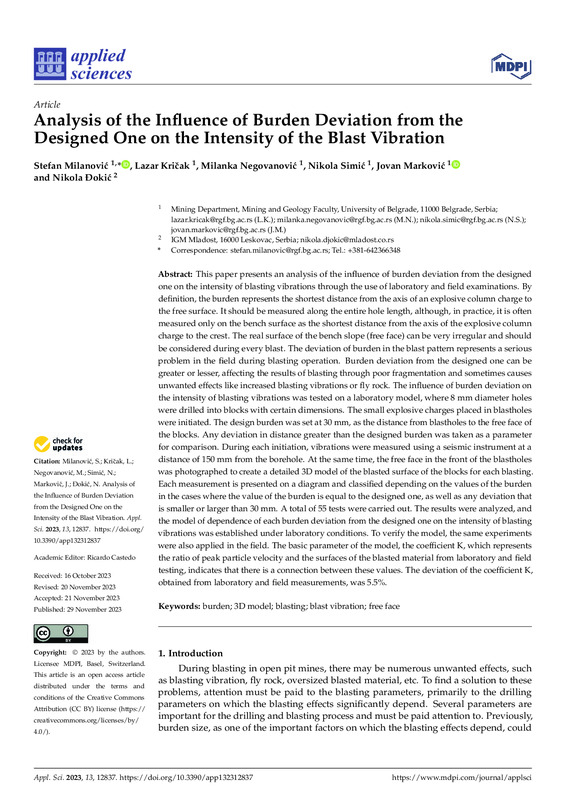Analysis of the Influence of Burden Deviation from the Designed One on the Intensity of the Blast Vibration
Објеката
- Тип
- Рад у часопису
- Верзија рада
- објављена верзија
- Језик
- енглески
- Креатор
- Stefan Milanović, Lazar Kričak, Milanka Negovanović, Nikola Simić, Jovan Marković, Nikola Đokić
- Извор
- Applied Sciences
- Издавач
- MDPI AG
- Датум издавања
- 2023
- Сажетак
-
This paper presents an analysis of the influence of burden deviation from the designed one on the intensity of blasting vibrations through the use of laboratory and field examinations. By definition, the burden represents the shortest distance from the axis of an explosive column charge to the free surface. It should be measured along the entire hole length, although, in practice, it is often measured only on the bench surface as the shortest distance from the axis of the explosive column charge to the crest. The real surface of the bench slope (free face) can be very irregular and should be considered during every blast. The deviation of burden in the blast pattern represents a serious problem in the field during blasting operation. Burden deviation from the designed one can be greater or lesser, affecting the results of blasting through poor fragmentation and sometimes causes unwanted effects like increased blasting vibrations or fly rock. The influence of burden deviation on the intensity of blasting vibrations was tested on a laboratory model, where 8 mm diameter holes were drilled into blocks with certain dimensions. The small explosive charges placed in blastholes were initiated. The design burden was set at 30 mm, as the distance from blastholes to the free face of the blocks. Any deviation in distance greater than the designed burden was taken as a parameter for comparison. During each initiation, vibrations were measured using a seismic instrument at a distance of 150 mm from the borehole. At the same time, the free face in the front of the blastholes was photographed to create a detailed 3D model of the blasted surface of the blocks for each blasting.
Each measurement is presented on a diagram and classified depending on the values of the burden in the cases where the value of the burden is equal to the designed one, as well as any deviation that is smaller or larger than 30 mm. A total of 55 tests were carried out. The results were analyzed, and the model of dependence of each burden deviation from the designed one on the intensity of blasting
vibrations was established under laboratory conditions. To verify the model, the same experiments were also applied in the field. The basic parameter of the model, the coefficient K, which represents
the ratio of peak particle velocity and the surfaces of the blasted material from laboratory and field testing, indicates that there is a connection between these values. The deviation of the coefficient K,
obtained from laboratory and field measurements, was 5.5%. - том
- 13
- Број
- 23
- број страница
- 20
- doi
- 10.3390/app132312837
- issn
- 2076-3417
- Subject
- linija najmanjeg otpora, 3D model, miniranje, potresi usled miniranja, slobodna površina
- burden, 3D model, blasting, blast vibration, free face
- Шира категорија рада
- M20
- Ужа категорија рада
- М22
- Је дио
- TR33003
- Права
- Отворени приступ
- Лиценца
- All rights reserved
- Формат
- Медија
 applsci-13-12837.pdf
applsci-13-12837.pdf
Stefan Milanović, Lazar Kričak, Milanka Negovanović, Nikola Simić, Jovan Marković, Nikola Đokić. "Analysis of the Influence of Burden Deviation from the Designed One on the Intensity of the Blast Vibration" in Applied Sciences, MDPI AG (2023). https://doi.org/10.3390/app132312837 М22
This item was submitted on 30. новембар 2023. by [anonymous user] using the form “Рад у часопису” on the site “Радови”: http://romeka.rgf.rs/s/repo
Click here to view the collected data.